
Projects are closed, it happens. Sometimes they have something to share. Even less often it turns out to be done. Under the cut - my descriptions of game characters for artists (even before joining Pixonic) and the resulting concept art.
NB! A significant part of the article is copy-paste from the project konf without special processing. This was done specifically to show the real workflow and working materials, and not their versions licked for public access.The structure and manner of description varies from character to character, because different artists need different details in the description, and my ideas about priorities and emphasis have changed over time. Within the framework of the concepts are already today's comments.
A few words about the project itself. Core Tactics is a synchronous top-down PvP shooter with 3D models, procedural generation of levels, physics, abilities and pavers. The game was actively made by a team of six people a little more than six months, the main USP is managing two characters at once. The mobile version was played by over 10k people (everything is organic), and the desktop version even went through a green light in Steam. But the last couple of years, development has been frozen.
Mobile phone gameplay:
Desktop version:
Next, I will show my descriptions of the characters and the results of the work of artists (which did not always coincide with the first ideas). It is important to understand that the gameplay and art always complement each other. It is not enough to ask to sketch a huge green monster with hooks instead of arms. Without an understanding of the mechanic’s set (what if it’s a support, not a tank?), It is likely that everything will have to be redone - even if visually done well and formally meets the requirements of the TOR.
1. Class: Rifleman. Name: NightGameplay Role: Specialist Hunter.
Archetype: Assassin.
Associations: shadow, willow tree, bullfighter, puppet, spider.Type: a thin tall man with prominent joints and long fingers. Never stands straight, constantly leaning in one or the other direction. Characteristic posture: sit cross-legged so that the ankle of one leg rests on the knee of the other. Between the legs of the gun barrel down, fingers folded on the butt, the chin rests on the wrist, shoulders hunched.
Abilities and features: rail shot, invisibility (with a visual effect by which you can guess a moving target), EMP (disables all modifications around itself for X seconds), Coup de Gras (applies only to those who are already “unconscious” - forbids their "revitalization").
Armor: a tight-fitting elastic suit with sewn-in plates, covered with patches from the same material. The plates are uneven and asymmetric (for example, the right clavicle is closed, and the left is not). The costume covers the whole body, there are no separate boots and gloves. There is no helmet, the hood fits the whole face, except the eyes (it just fits so that the lines of the face are visible). In front of the eyes and under the hood - high-tech glasses, such as:
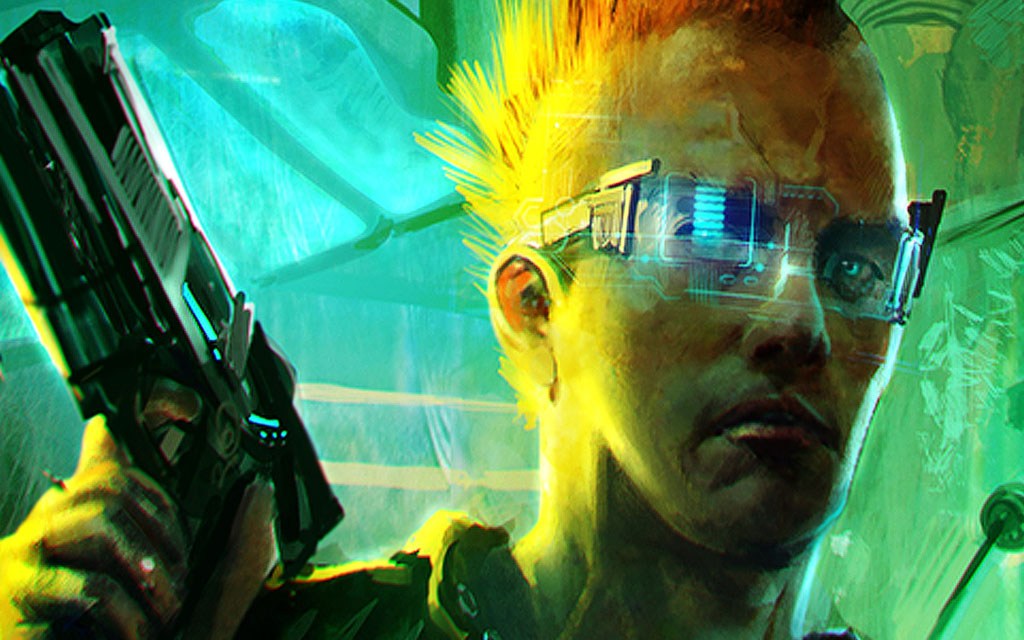
Under the eye there is a tattoo in the form of three filled tears (meaning and refs see, for example,
here ). A flexible generator-battery or another energy source with a once-glowing element stretches along the spine, but is now broken (for example, several sections are knocked out and do not glow), along the entire length are artisanal grooves, from which wires stretch to the tool.
Weapon: something classic in the spirit of the M16, but with a thicker body. The railgun installation is welded to the side, according to general sensations - something is not at all elegant. The butt of the weapon is greatly increased and connected by many thick wires to the tool - a handicraft portable generator / battery / other energy source. Wires - wrapped in the same material.
Tulsa is attached to the body with the same material (on the chest / back / thigh / above the shoulder), luminous elements and irregularities are guessed even through the material. At the cast time of a rail shot, the tool starts to glow brighter and flashes at the end. At the cast time of invisibility, the whole figure gradually becomes transparent, starting from the place where the tool is located.
General description of weapons: assault rifle in the form in which it could appear in reality in 30-50 years.
Gameplay: shoots "C grade", as in CS. It makes three quick shots (pause between shots 0.4 seconds) → a short pause (1.6 seconds) → three more shots. In a clip of 12 rounds, if run out, it takes to reload (4.3 seconds). Before firing, it “warms up” (1 second is prepared). Each shot is a separate instance. Deals medium damage. May criticize. You can dodge the shots.
Wishes for visualization: associations with shooting from AK or M16 from Contra.
The result :
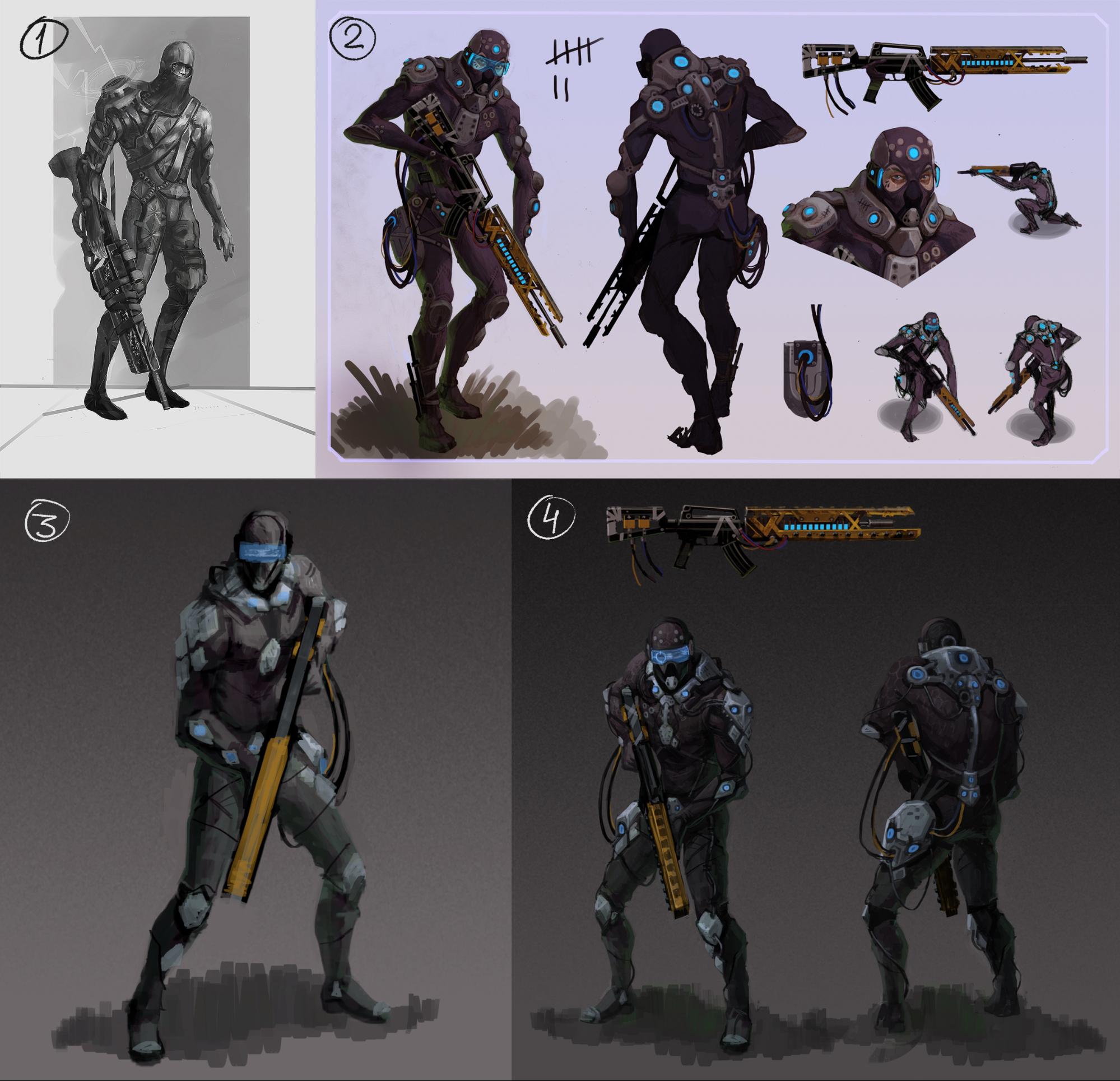 1) Draft from the art lead. 2) The first option from a concept artist. 3) The second option after editing from the art lead. 4) The final concept.
1) Draft from the art lead. 2) The first option from a concept artist. 3) The second option after editing from the art lead. 4) The final concept.This was the first character we started discussing with an art lead. I tried to formulate not individual elements of appearance, but the general sensation of the image. Judging by the feedback, it was possible - the concepts were made quickly, the character immediately fell in love with the team, the gameplay was read from the image.
But despite this, in the game itself, the character looked either a black spot or lit up and did not cause the necessary sensations. Because in the dynamics of the battle with the top down camera, the elements that I described are not important at all.
In the process of iterative work, the second conceptor proposed his own version. He didn’t enter the team like that, but he raised a lot of questions, answering which, we came to the final result.
2. Class: Assaulter. Name: Cpt. YGameplay Role: Tank Initiator.
Archetype: paladin.
Associations: cop, father, leader, retired athlete, knight.General description of appearance: a man over 40 stocky physique, with a wide bald head framed by neat gray hair. Strong-willed chin, prominent cheekbones, stiff brush of gray mustache. There is a deep crease between the eyebrows. A powerful nose with traces of fractures, but without a pronounced deformation. In the most ordinary glasses.
Characteristic posture: before the battle, when shots are already heard on the horizon, and the whole team pressed against the wall and is ready to jump out at the command on the enemy, stands a little apart from the rest, with an open helmet, holds a photo in his hands and kisses it.
Armor: covers the entire body (except the head), heavy even in appearance, with strongly accented collar and shoulders. Servo amplifiers all over the armor (see the seismic warhammer):
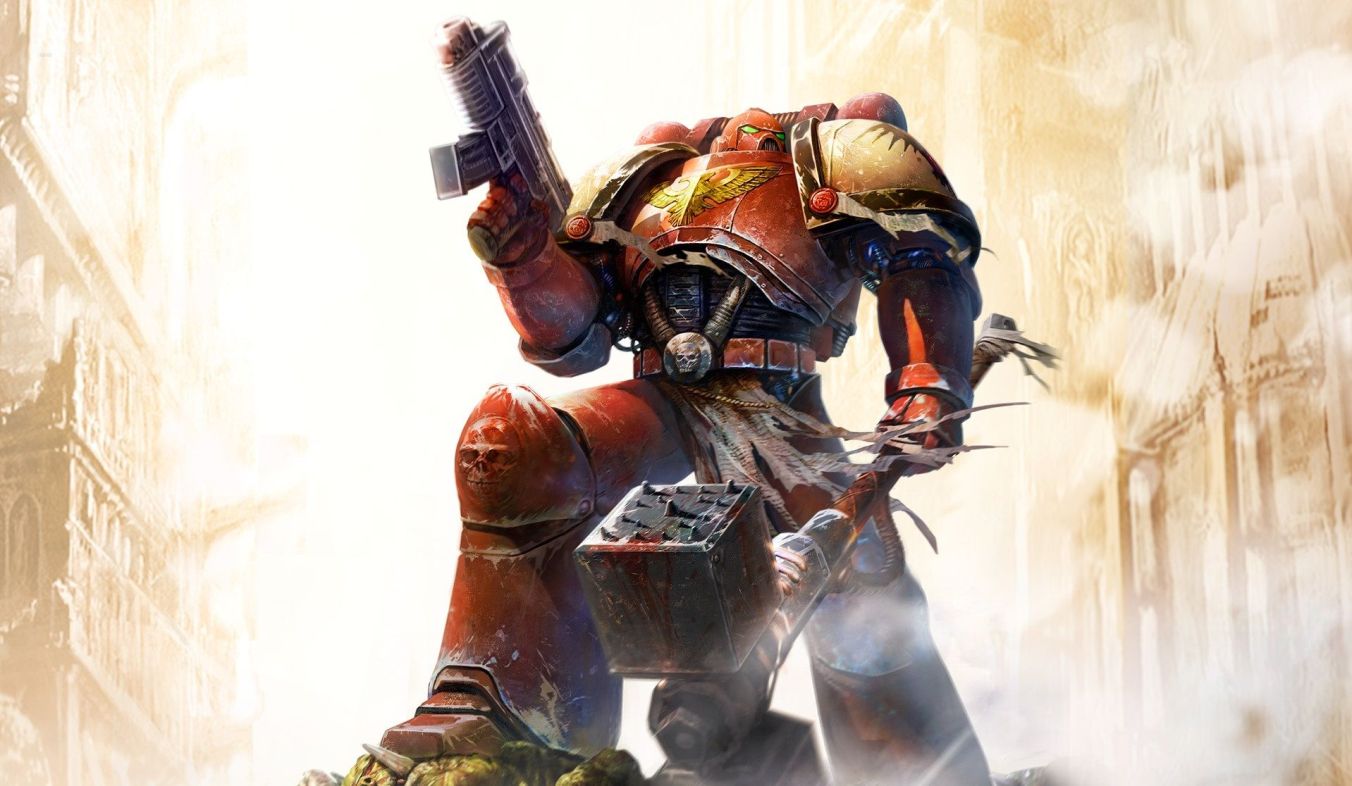
The head is covered with a transparent domed helmet extending into the collar zone. An AR projection of the terrain with infographics is superimposed on the inner surface of the helmet. A glued photograph is guessed inside the helmet. A knitted turtleneck collar is visible on the neck. On the back is a jump pack. On the feet are separate mini-motors / amplifiers / inertia dampers. In armor there are patches from "left" materials (for example, a piece of a car body), traces of rough welding. In the foot and hand armor - special openings for storing / loading weapons.
General description of the weapon: a shotgun in the form in which it could appear in reality in 30-50 years.
Gameplay: ready to fire immediately - does not require heating. Releases a clip (8 rounds, 0.68 seconds between shots) and goes to reload (3 seconds). Shoots at the minimum distance.
Each shot is a separate instance. The amount of damage depends on the distance to the target: it inflicts a lot of damage close to the target (one and a half times less than from a grenade launcher, 7 times more than 1 bullet from a machine gun), at the maximum distance from the target - it is comparable to the damage from an assault rifle. Do not criticize, you can dodge.
Wishes for visualization: not 1 bullet, but a cloud of fractions.
Tulsa: jump pack + additional motors / amplifiers / compensators on the legs.
Chips: take off with the help of a jetpack and stick from the height into the ground (destroying geometry, deforming the terrane, introducing damage and discarding everyone who is nearby). With the help of foot engines, bounce sharply back a short distance. Use the tactical interface to shoot at targets through walls if other characters in the party see them.
The result :
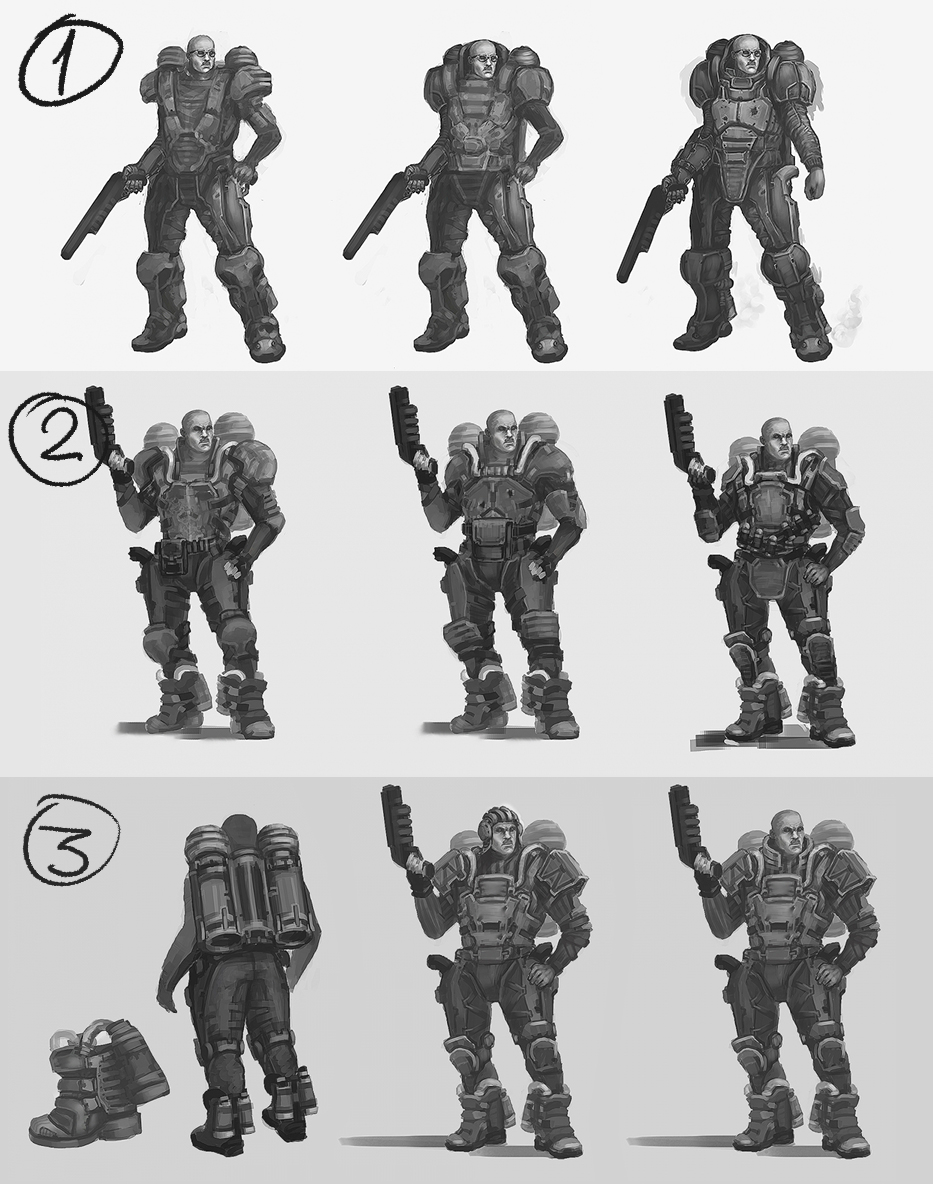 All three images are variations from the art lead on the theme of bib / boots / helmet / turbine.
All three images are variations from the art lead on the theme of bib / boots / helmet / turbine.The second character employed. The description format was like that of the first. The feedback from the team is also similar, but in the process of work it turned out to avoid most of the negative aspects. The position “I see it like this, but you can change everything that you consider necessary, helped in this - use the description only as a starting point”.
Separately, I note that in the discussion of the concepts and details of this character the whole team vividly joined. Because of this, the final implementation in details is very different from the description, but it conveys the necessary feelings even better - because it works with the perceptions of not one artist, but a whole group of very different people.
3. Class: Grenader. Name: RichieGameplay role: artillery.
Archetype: young genius, techie, boy in armor.
Associations: playing with fire, golem, subcultures, madman, kamikaze.A 15-year-old teenager in a non-continuous exoskeleton of poisonous-screaming colors and body armor over a sweatshirt, such as this:

Wide trousers, a hood over the helmet, something like here:
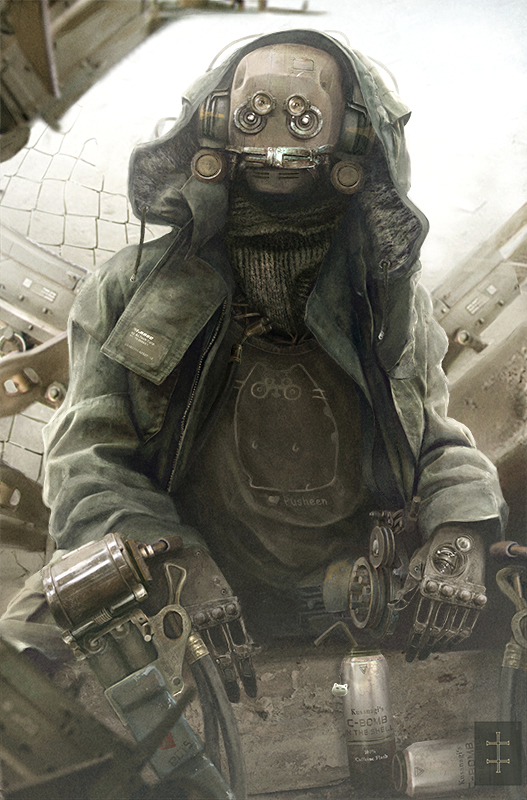
A headset with a microphone is clearly visible (we look at any modern pro-gaming headsets). Traces of oil / burn marks on the clothes, piercings are visible under the helmet (for example, a chain from ear to lip). The clothes are emphasized thick (so as not to get burned about overheating exoskeleton). There is a radical print backpack on the back. Sex is undefined. The waist is belted twice with a belt crosswise on a cross, on a belt there are grooves where clips, grenades, tools and spray cans are mixed with paint.
General description of the weapon: a grenade launcher in the form in which it could appear in reality in 30-50 years.
Before firing, it “warms up” for 2 seconds. It shoots very far, with AoE, which hits both its own and others. The projectile flies to a point - you can escape from it. A shell explodes in a collision - if someone gets in the way, there will be an explosion. After the shot, it recharges 5.4 seconds. Do not criticize, you can not dodge.
Wishes for visualization: associations with the rocket launcher from Quake.
On the exoskeleton, multiple repair traces, crumpled elements, some completely replaced with spare parts from other mechanisms. On one thigh there is a massive bag with ammunition, on the other (up to the knee) there is an expanded tool case. An exoskeleton has only 1 hand, into which a grenade launcher is soldered, approximately as in the picture (only assembled from different parts and without a drum):

Characteristic posture: hang with your hand in the exoskeleton on the ledge and draw with a free hand on the wall with a spray can, biting zeal of the tip of the tongue with zeal.
Chips: launching a particularly powerful grenade, launching a smoke grenade, taking off and ramming with the exoskeleton shoulder of everyone in the way with the destruction of geometry, overload (runs X times faster, shoots and reloads, but all this time it takes damage and rises at the end of the action for X times without movement and can’t do anything).
The result :
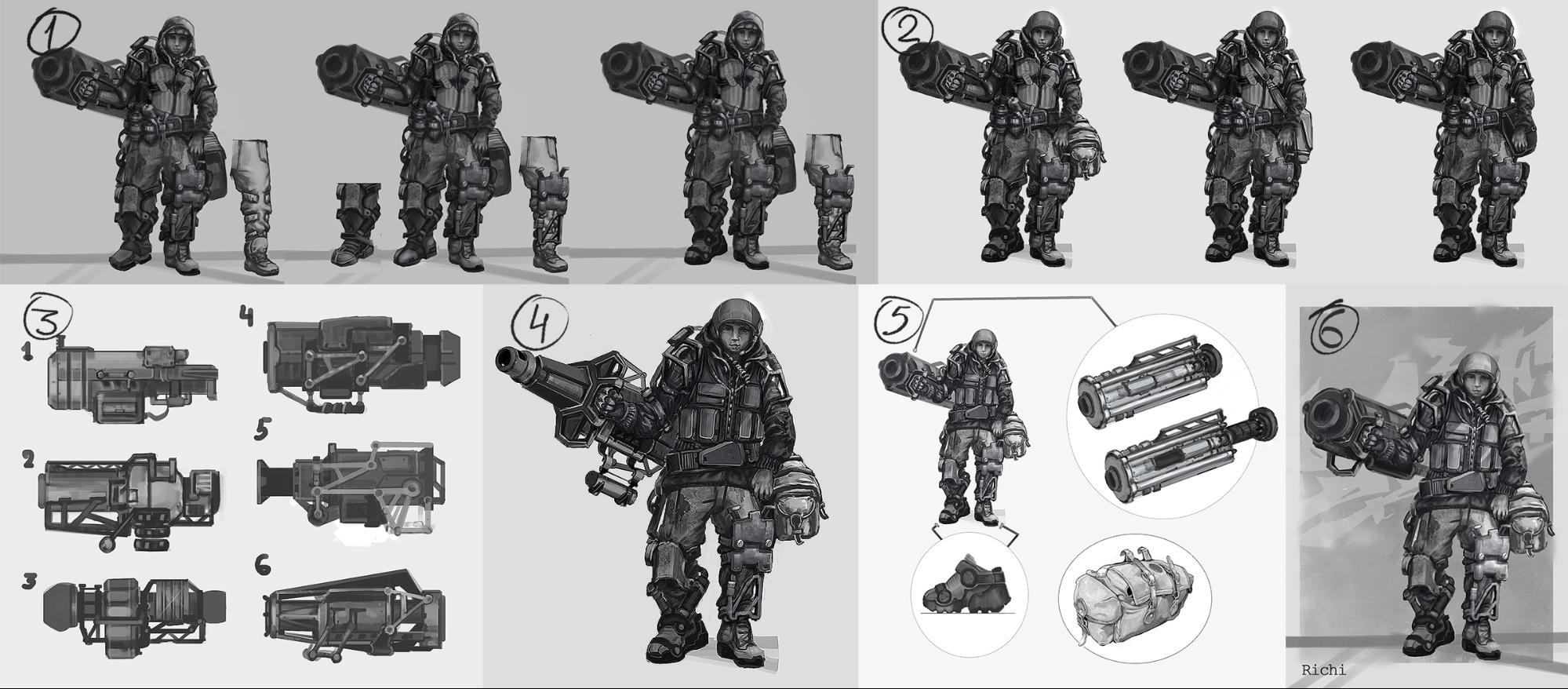 1) The concept of a partial exoskeleton. 2) Search for bags. 3) Search for weapons 4) Trying on weapons. 5) The approved concept, separate nuances are drawn for the modeler and animator. 6) The final concept.
1) The concept of a partial exoskeleton. 2) Search for bags. 3) Search for weapons 4) Trying on weapons. 5) The approved concept, separate nuances are drawn for the modeler and animator. 6) The final concept.The main difficulty in working on this character is to combine the fragility of a teenager and the massiveness of an exoskeleton in order to obtain an image of a ± standard size without a “tank” feeling. It was in work on this image that we tried the option of quick sketching of individual elements - a bag, helmet, boots. Now I understand that each of these elements individually was not very important for the character in the realities of a particular project, but - it was important for us to find a common language with the art lead in matters of forms, materials, colors. Thanks to the extra week of time spent on such a study, we saved a few days in the work on subsequent characters. Now I adhere to just such an approach in such problems.
4. Grade: Machinegunner. Name: ColonelGameplay Role: Sustainer Duelist.
Archetype: maniac.
Associations: military, psychopath, M.Bison from Street Fighter, dictator of the banana republic, Rasputin.General description of appearance: a stocky man of medium height in an overcoat unbuttoned with reinforced armor plates with a colonel's stars on epaulets (according to the Soviet model), under which is light body armor. On the legs are pants a la breeches and army berets of a new sample. The head is massive, almost square, with brightly defined cheekbones and chin. The head is not covered, you can see the neatly styled hairstyle a la America of the 20s. The face is completely covered by an anatomical mask with slots for the eyes and small ventilation holes in the area of the nose and mouth. Source for inspiration:

The mask looks matte, like porcelain. One eye has been replaced by a cybernetic prosthesis with a laser target designator (source for inspiration: Terminator). A wide and thick beard shovels down from the face. A belt with a heavy machine gun is thrown over his left shoulder. Most of the time, the machine gun is located behind the right and hangs with the barrel down (a sense of negligence), but when the need arises, the character pulls the machine gun with his right hand and is ready for battle. On the belt there is a wide army belt with a distinguished brass / gold buckle. Heavy machine gun, but not stationary:

Charges on a drum basis. The drums themselves are like flat pancakes and are placed on the inner surface of the overcoat.
General description of the weapon: a heavy machine gun in the form in which it could appear in reality in 30-50 years.
Gameplay: it takes a long time to spin (3 seconds), after which it spits out the entire clip very quickly (40 shots, a pause between shots of 0.1 second) and takes a long reload time (6 seconds). Fires farther than a shotgun, but closer than an assault rifle.
Each shot is a separate instance, does little damage (two thirds of the damage of an assault rifle). Can criticize, you can dodge.
Wishes for visualization: arouses associations with Rambo.
Characteristic posture: standing in the thick of the battle, stepping on a dead person with his foot. Bullets whistle around, grenades explode, overcoat floors fly apart from the shock wave; his right hand rests on a steaming, cooling machine gun, his left holds a pocket watch on a chain that stretches to the inside pocket of his greatcoat.
The result :
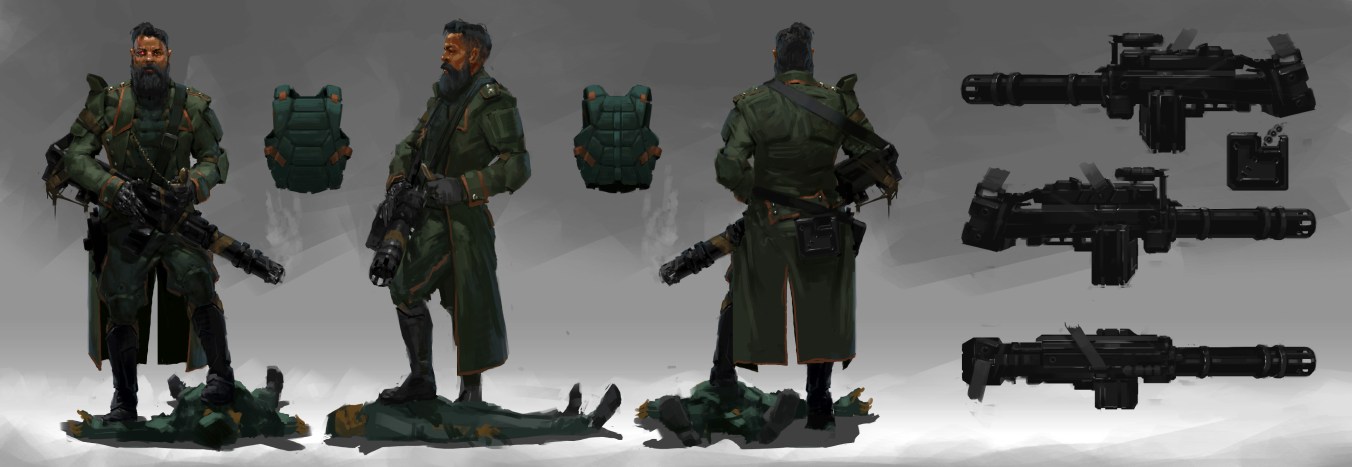 A rare case when a conceptor without any sketches immediately fell into the mood and image.
A rare case when a conceptor without any sketches immediately fell into the mood and image.This image is made by an outsourcer, without intermediate communication and discussion. All that was required was the already familiar description format and purely technical details worked out by the art leader in the process of working on previous characters.
The concept came out quickly and everyone liked it (the leftmost image). But in order to bring it to a state for the modeler, when he clearly understands what and how to do (a character from all angles), we spent three times more than usual time. The reason is that the outsourced conceptor is not used to independently think over such aspects, and the modeler was brought to discussion only at the final stage, when making any changes is much more complicated and expensive.
5. Grade: Machinegunner. Name: Dr. VestaArchetype: wise guy.
Associations: female scientist, fury, BDSM mistress, female engineer from Ghostbusters.General description: a slender woman of medium height in pink overalls emphasizing the protruding parts of the body (and a little baggy in other places). Most of the pockets of the overalls look full. On the shoulders there is a heavy unbuttoned jacket covered with armored plates with stylized epaulettes, held on several metal chains. Under the jacket - a futuristic analogue of body armor, covering only the torso. Hair is gathered in a tall, tightly pulled tail. Before my eyes, VR glasses.
On the belt there is a belt with tools and rolled up twisted pair (associations with a whip). The forearms are bare, the skin is milky white, on the fingers are glossy tight gloves. In the hands of a powerful remote control for drone control with an emphasis on the antenna. Behind a large quadrocopter with a protruding machine gun.
The result :
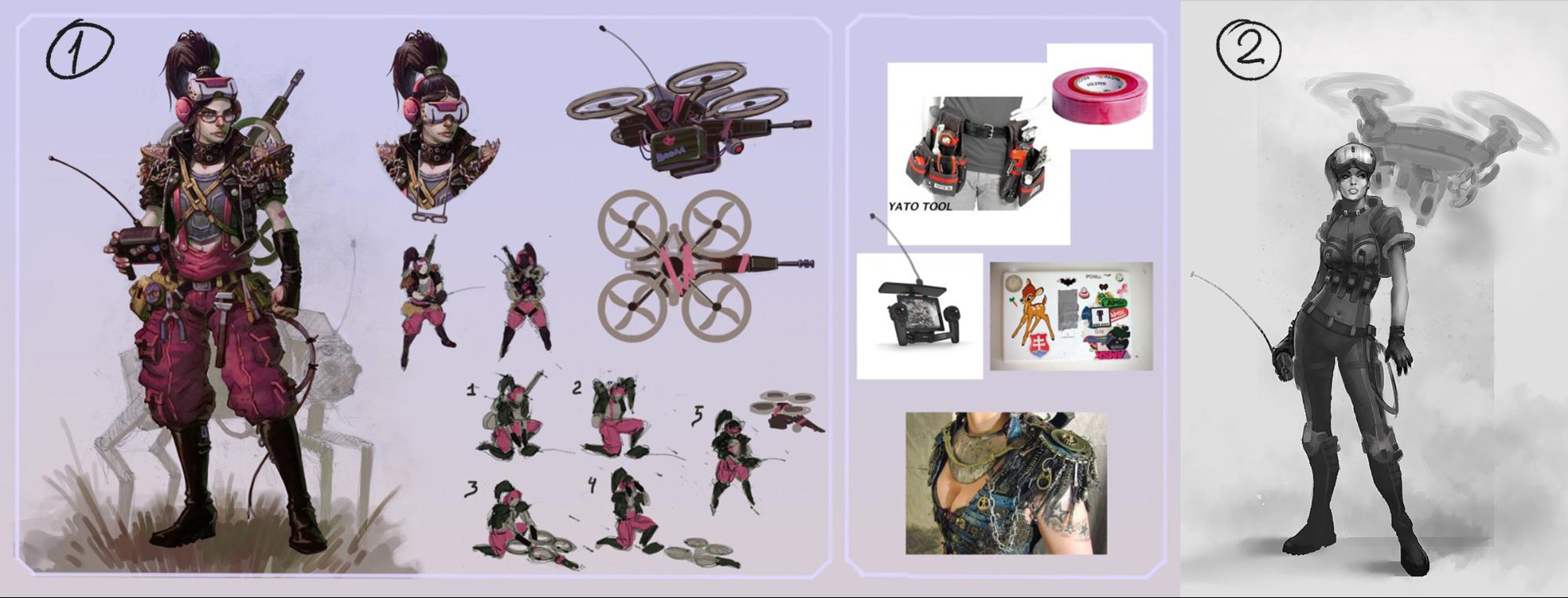 1) Option from a concept artist, not taken to work. 2) The variant from the lead was also not taken.
1) Option from a concept artist, not taken to work. 2) The variant from the lead was also not taken.The character did not have time to appear in the game. One of the reasons is the strong difference between the visual gamut and the means of expression used by the conceptor (first option). To ignore specific visual solutions, to see color spots, shapes, nuances behind them - this skill is not often found outside the art workshop. I still regret that I didn’t guess in advance to say this aspect and warn the conceptor. The second option - a deliberate attempt by an art leader to come to the usual team decisions on color, shape, means of expression - seemed too "neutral" and did not catch on.
6. Class: Rifleman. Name: LissArchetype: Trickster.
Associations: Parker, extreme girl, Harley Quinn (“Suicide Squad”), Jinx (LoL).General description: a young girl of short stature in short shorts. On the face of freckles, an eternal expression of anticipation of some kind of trick, a bitten lower lip. Long thick hair below the buttocks is braided into a thick braid, caught at the end. Eyes are closed by a continuous protection (a la construction glasses) with a projected infographic.
Hands from the wrist to the elbow and the legs from the ankle to the knee are covered with a la rolling protection, the torso and shoulders are covered with solid plate futuristic armor. The armor ends on the palm above the navel (a kind of armored top), from the back it reaches the base of the skull and gently supports the neck. A thick belt with a large buckle (for example, in the form of a Cheburashka) is loosely wrapped around the belt several times. Legs are low and wide high-tech boots. On the hands are fingerless gloves, on the back there are reinforced plates. He stands with bent legs, on a massive hoverboard (like Marty McFly's "Back to the Future 2"). Behind the belt is a futuristic assault rifle.
The result :
 1) The very first version of the concept. 2) Another one. 3) Here the artist received a carte blanche to do as he sees fit. 4) Finalization.
1) The very first version of the concept. 2) Another one. 3) Here the artist received a carte blanche to do as he sees fit. 4) Finalization.This concept was carried out by the same outsourced artist who painted Colonel. The first version didn’t enter right away, and when working with the feedback again, difficulties arose. We spent a week, but after the stage “the team draws with the artist’s hands”, they decided to pause.
Then the artist started the task from scratch and the new concept was already recognized as final.
7. Class: Robot. Name: LFArchetype: jack of all trades.
Associations: stuffed animal, puppet, cowboy, crash test dummy, robot from "I, Robot".Robot for practicing military maneuvers, tactics and firing. The general silhouette repeats the human (male, medium height, athletic complexion) without soft tissues. Places where a person would have arteries protrude on top of the general silhouette and are highlighted. The joints are closed with additional rounded protective elements.
In the chest area there is a control unit and a power source. There are servo motors and drives capable of repeating human plasticity that have been taken to the area of the head analyzers. All these elements are covered with a thick layer of elastic, inertia-quenching gel, on top of which there is a continuous mosaic of transparent armor plates that read hits and, if necessary, are filled with a pseudo-volumetric image that imitates one or another type of camouflage.
LF includes serious military tactical, linguistic and simulation modules. To what is happening, he gives out reactions in the form of tactical recommendations, supports the conversation, but communicates in a strictly hierarchical and concrete spirit.
Over the years of semi-autonomous existence, LF has developed a distant semblance of personality. In appearance, this manifests itself in a long, wide, Mexican-style scarf and hat.
In battle, actively uses abilities tied to tactical genius, communication, coordination and information warfare. Most often acts as a tank armed with a shotgun.
The result :
 1-2) Art lead is looking for the right image. 3) Art lead suggests changing the image. 4) The final concept.
1-2) Art lead is looking for the right image. 3) Art lead suggests changing the image. 4) The final concept.This concept was drawn by the art lead itself, but after a long break in working on the concepts. Several iterations did not go to the team from the word “completely” and we used a proven tool - we asked to draw our vision, and take the description as a starting point. The result turned out to be interesting, but they did not have time to make a decision - the project has already been closed.
8. Class: Electrogun. Name: Prof. GrayArchetype: girl with glasses, teacher girl.Beautiful natural beauty woman in tight armor, sci-fi glasses, hair tidied up in an intricate (but neat) hairstyle. Variations of hairpins are possible. The armor guesses the elements of a lab coat / austere pencil skirt. Variations with pens / pencils / notebooks / tablets are possible. A powerful source of energy is built into the armor, connected by wires to the gun.
The weapon is massive, but fragile and light. It evokes the feeling of a prototype. When firing, it constantly hits the target with an electric ray, something like this:
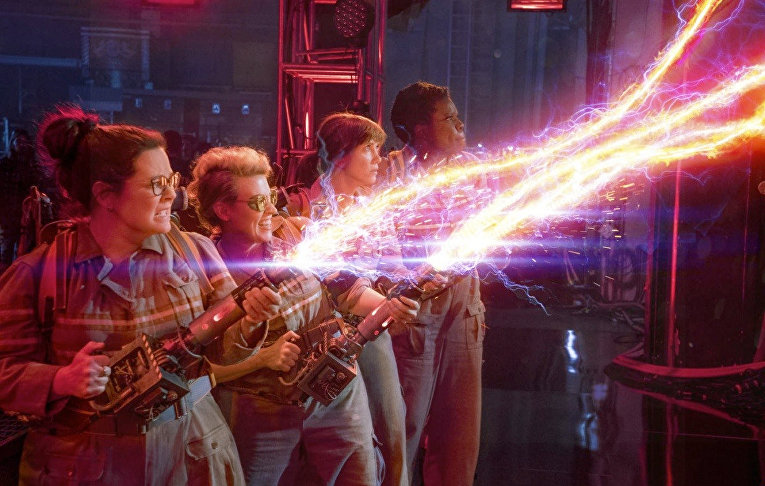
Sources of inspiration: Miranda Lawson from MEII, Megan Reed from Deus Ex, Kyoko Minazuki from Rival Schools, Meredith Vickers from Prometheus.
Basic Attacks: A beam that constantly roasts an enemy at medium range. Medium warm-up, quick cooling, no recharge, medium-high damage. The ray is interrupted by other characters / geometry.
Unique abilities: overheating (multiplier to the damage from x1.1 to x3 in 5 seconds), inversion shield (shield on X hp, with each hit on the shield burns energy from the attacker), EMR grenade, causing energy damage.
The result :
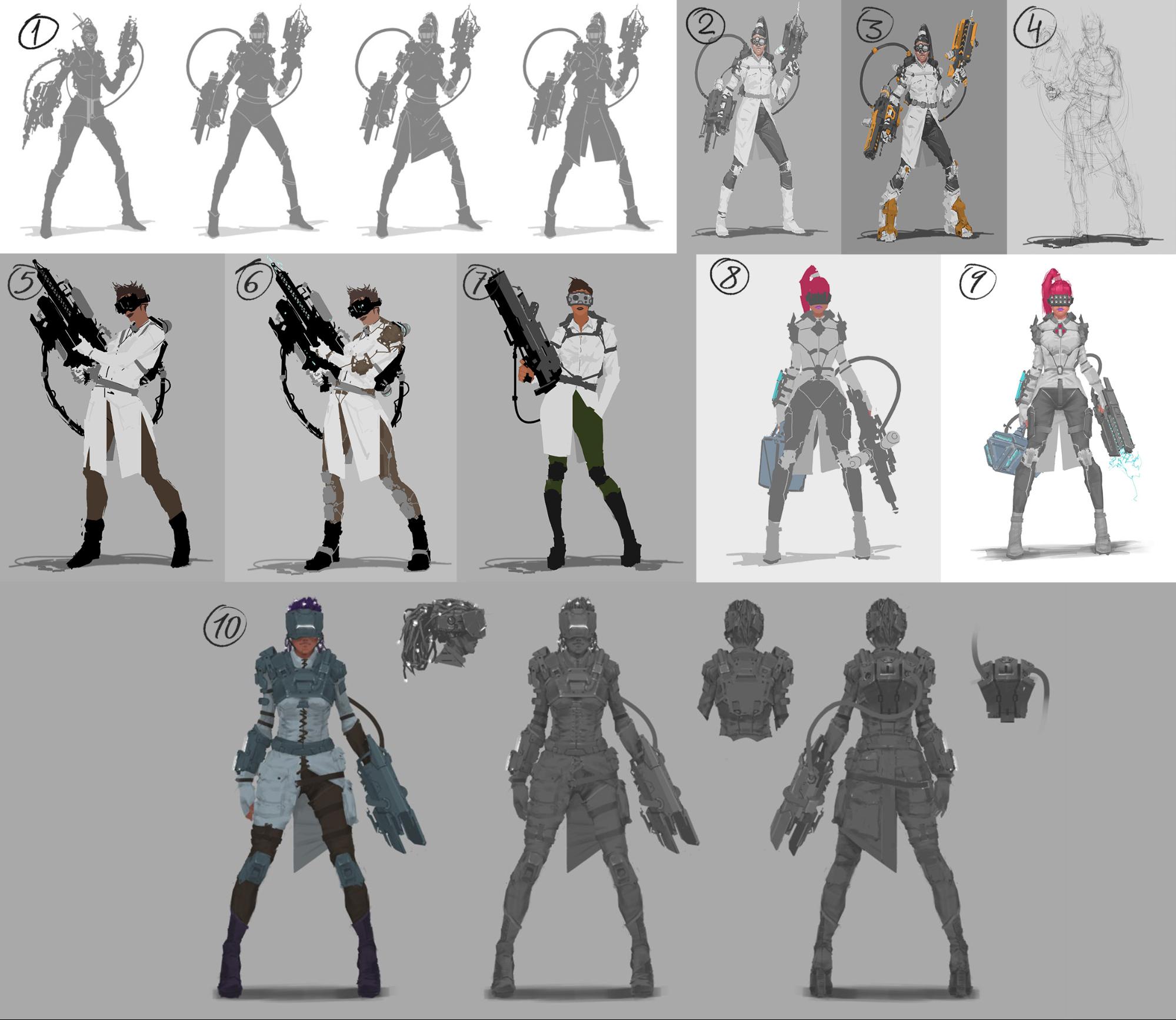 1) Silhouette search. 2) and 3) Detailing the silhouette option. 4) The proposal of the concept artist in a new image. 5), 6) and 7) Detailing. 8) Search. 10) The final.
1) Silhouette search. 2) and 3) Detailing the silhouette option. 4) The proposal of the concept artist in a new image. 5), 6) and 7) Detailing. 8) Search. 10) The final.This concept is a good example of working with the same person who is not used to feedback and iterations. As a result, the conceptionist Liss and Colonel walked with the team on all the fundamental aspects of the character, and only after that set about embellishment and small details. The result was supposed to be the next character in the project.
9. Class: Pistolier. Name: ???There was another character, and the TK to him completely sounded like this: “Armed with several pistols, at the same time shoots at different targets.”
It turned out pretty well:
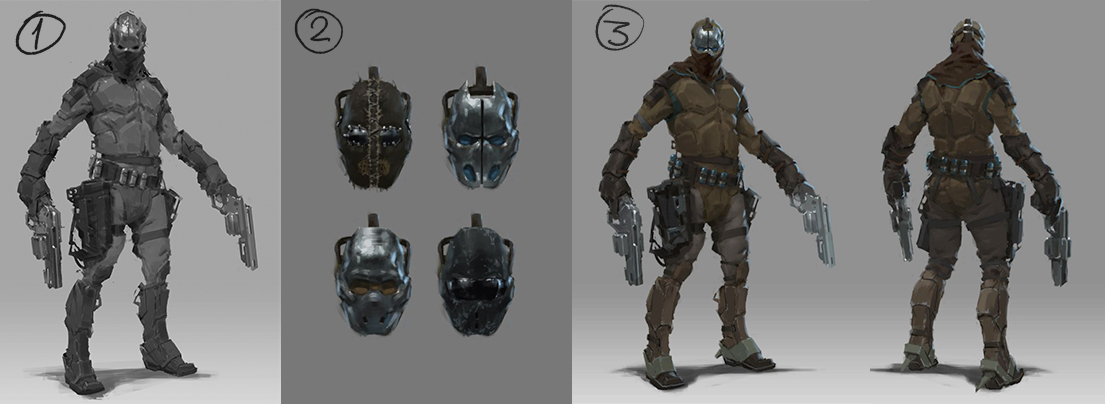
Character - an attempt to take a fresh look at the images. After discussion and attempts to formalize the request for “something new,” the idea came up to work without any description at all. Only functionality with an absolute minimum of detail. The result was no worse than the rest of the concepts, and the logical question arose:
Is it necessary to spend time on all discussions, descriptions, and iterations?Of course, there is no one right approach to setting goals for a concept, or to accepting them, or to fulfilling them. Different things can work with different people and at different stages, but something can be summed up. For example:
- When working with outsourcing, not only write out the TOR, but also immediately discuss your workflow. This will save a lot of time in the final stages.
- Do not go in cycles in the first concepts or the description, everything can very much change (and become even better).
- Look not only at how the result is consistent with the TOR, but also how it looks in the game. Perhaps the idea itself was initially unviable given a particular setting, camera, genre, or mechanic.
- Listen to your colleagues. We all consider ourselves professionals in all areas, but sometimes it is better to give freedom of action to those who really have more experience.
- When writing TK, keep in mind that people cannot read your mind. Write in detail.
- Not the fact that the first, second, or third iteration will hit the target. If you expect that someone will embody exactly your idea of a character or object - you should be able to speak his language. To come to this at the first iterations is unlikely.